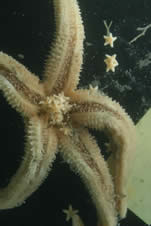
 |
| Academic Departments | Student Services | Alumni | Research | Outreach | Diversity |
Daily Journal Questions Participants
Sponsored by:

Background
The southernmost continent of Antarctica is the fifth largest continent and the coldest and driest place on earth. Antarctica separated from the southern tip of the South American continent approximately 30 million years ago and has been isolated since. During this time, many of the marine animals living around Antarctica have evolved and are now different than any other animals in the world. These endemic animals are unique to Antarctica and include worms, molluscs, echinoderms, crustaceans and many others. However, some of the animals are able to live in both Antarctic and South American waters.

This research effort is looking at how the larval forms of some marine animals move between Antarctica and South America. By using plankton nets, we will look for larvae actually moving across the Drake Passage - one of the roughest bodies of water in the world. Because larvae are so small and the Drake Passage is so big, this will be like looking for a needle in a haystack.
However, we have found larvae in the Drake Passage on previous cruises in 2000, 2001 and 2004. Once we get back home, we will use genetic (DNA) tools on larvae and adults collected in Antarctica and South America to determine if animals in both locations are closely related. The best explanation for how these areas stay closely related is that larvae, not the adults, move long distances. In order to collect adults to investigate their DNA, we will use several different pieces of equipment to sample the shallow sea floors around the tip of South America and around Antarctica, at depths up to around 200 meters (around 600 feet). To collect the larvae forms, we will use plankton nets in the much deeper waters of the Drake Passage to capture the larvae as they travel across from one continent to the other. After collecting these animals, they will be identified on the boat based on their outward appearance, or morphology. We will then preserve the animals in a deep freezer so that we can study their DNA back in the laboratory. The DNA of larvae will also be used as a way to identify them since they are so tiny and very difficult to identify based on outward appearances, so we can match up the DNA from the larvae to the DNA from the adults and figure out which larvae belong to each adult animal.
- Alabama Agricultural Experiment Station
- Alabama Cooperative Extension System
- Auburn Online Community
- Bookstore
- Center for Diversity
- Crisis/Incident Assistance
- Diversity and Multicultural Affairs
- Financial Aid
- Hotel and Conference Center
- Jule Collins Smith Museum of Fine Art
- Medical Clinic
- Southeastern Raptor Center
- Special Reports
- Students w/ Disabilities
- Theatre